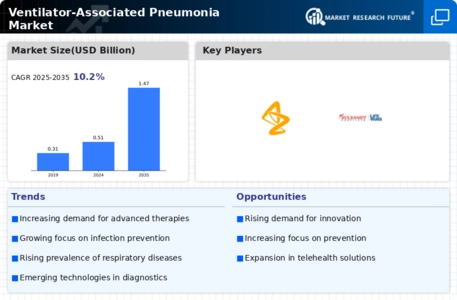-
REPORT PROLOGUE
-
MARKET INTRODUCTION
-
Definition
-
Scope of the Study
- Research Objective
- Assumptions
- Limitations
-
RESEARCH METHODOLOGY
-
Overview
-
Primary Research
-
Secondary Research
-
Market Size Estimation
-
MARKET DYNAMICS
-
Overview
-
Drivers
-
Restraints
-
Opportunities
-
MARKET FACTOR ANALYSIS
-
Porter’s Five Forces Analysis
- Bargaining Power of Suppliers
- Bargaining Power of Buyers
- Threat of New Entrants
- Threat of Substitutes
- Intensity of Rivalry
-
Value Chain Analysis
-
-
GLOBAL VENTILATOR-ASSOCIATED PNEUMONIA MARKET, BY DIAGNOSIS
-
Overview
-
Clinical
-
Market Estimates & Forecast, by Region, 2020-2027
-
Market Estimates & Forecast, by Country, 2020-2027
-
Radiological
-
Market Estimates & Forecast, by Region, 2020-2027
-
Market Estimates & Forecast, by Country, 2020-2027
-
Microbiological
-
Market Estimates & Forecast, by Region, 2020-2027
-
Market Estimates & Forecast, by Country, 2020-2027
-
Blood and pleural fluid cultures
-
Market Estimates & Forecast, by Region, 2020-2027
-
Market Estimates & Forecast, by Country, 2020-2027
-
Nonquantitative or semi quantitative airway sampling
-
Market Estimates & Forecast, by Region, 2020-2027
-
Market Estimates & Forecast, by Country, 2020-2027
-
Quantitative cultures of airway specimens
-
Market Estimates & Forecast, by Region, 2020-2027
-
Market Estimates & Forecast, by Country, 2020-2027
-
Others
-
Market Estimates & Forecast, by Region, 2020-2027
-
Market Estimates & Forecast, by Country, 2020-2027
-
GLOBAL VENTILATOR-ASSOCIATED PNEUMONIA MARKET, BY END USER
-
Overview
-
Hospitals & Clinics
-
Market Estimates & Forecast, by Region, 2020-2027
-
Market Estimates & Forecast, by Country, 2020-2027
-
Research and Academic Institutes
-
Market Estimates & Forecast, by Region, 2020-2027
-
Market Estimates & Forecast, by Country, 2020-2027
-
Ambulatory Care Centers
-
Market Estimates & Forecast, by Region, 2020-2027
-
Market Estimates & Forecast, by Country, 2020-2027
-
Others
-
Market Estimates & Forecast, by Region, 2020-2027
-
Market Estimates & Forecast, by Country, 2020-2027
-
GLOBAL VENTILATOR-ASSOCIATED PNEUMONIA MARKET, BY REGION
-
Overview
-
Americas
- North America
- Latin America
-
Europe
- Western Europe
- Eastern Europe
-
Asia-Pacific
- Japan
- China
- India
- Australia
- South Korea
- Rest of Asia-Pacific
-
Middle East & Africa
- Middle East
- Africa
-
COMPANY LANDSCAPE
-
Overview
-
Competitive Analysis
-
Market Share Analysis
-
Major Growth Strategy in the Global Ventilator-Associated Pneumonia Market
-
Competitive Benchmarking
-
Leading Players in Terms of Number of Developments in the Global Ventilator-Associated Pneumonia Market
-
Key developments and Growth Strategies
- New Product Launch/Service Deployment
- Merger & acquisitions
- Joint Ventures
-
Major Players Financial Matrix & Market Ratio
- Sales & Operating Income 2020
- Major Players R&D Expenditure 2020
-
Major Players Capital Market Ratio
-
COMPANY PROFILES
-
Adenium Biotech ApS
- Company Overview
- Product Overview
- Financial Overview
- Key Developments
- SWOT Analysis
- Key Strategies
-
Merck & Co., Inc.
- Company Overview
- Product Overview
- Financial Overview
- Key Developments
- SWOT Analysis
- Key Strategies
-
AstraZeneca
- Company Overview
- Product Overview
- Financial Overview
- Key Developments
- SWOT Analysis
- Key Strategies
-
MedImmune
- Company Overview
- Product Overview
- Financial Overview
- Key Developments
- SWOT Analysis
- Key Strategies
-
Nabriva Therapeutics AG
- Company Overview
- Product Overview
- Financial Overview
- Key Developments
- SWOT Analysis
- Key Strategies
-
Thermo Fisher Scientific
- Company Overview
- Product Overview
- Financial Overview
- Key Developments
- SWOT Analysis
- Key Strategies
-
Bayer AG
- Company Overview
- Product Overview
- Financial Overview
- Key Developments
- SWOT Analysis
- Key Strategies
-
Wockhardt
- Company Overview
- Product Overview
- Financial Overview
- Key Developments
- SWOT Analysis
- Key Strategies
-
Shionogi Inc.
- Company Overview
- Product Overview
- Financial Overview
- Key Developments
- SWOT Analysis
- Key Strategies
-
Cardeas Pharma
- Company Overview
- Product Overview
- Financial Overview
- Key Developments
- SWOT Analysis
- Key Strategies
-
Others
-
APPENDIX
-
References
-
Related Reports
-
-
LIST OF TABLES
-
GLOBAL VENTILATOR-ASSOCIATED PNEUMONIA MARKET SYNOPSIS, 2020-2027
-
GLOBAL VENTILATOR-ASSOCIATED PNEUMONIA MARKET ESTIMATES & FORECAST, 2020-2027 (USD MILLION)
-
GLOBAL VENTILATOR-ASSOCIATED PNEUMONIA MARKET, BY DIAGNOSIS, 2020-2027 (USD MILLION)
-
GLOBAL VENTILATOR-ASSOCIATED PNEUMONIA MARKET, BY END USER, 2020-2027 (USD MILLION)
-
GLOBAL VENTILATOR-ASSOCIATED PNEUMONIA MARKET, BY REGION, 2020-2027 (USD MILLION)
-
NORTH AMERICA: VENTILATOR-ASSOCIATED PNEUMONIA MARKET, BY DIAGNOSIS, 2020-2027 (USD MILLION)
-
NORTH AMERICA: VENTILATOR-ASSOCIATED PNEUMONIA MARKET, BY END USER, 2020-2027 (USD MILLION)
-
US: VENTILATOR-ASSOCIATED PNEUMONIA MARKET, BY DIAGNOSIS, 2020-2027 (USD MILLION)
-
US: VENTILATOR-ASSOCIATED PNEUMONIA MARKET, BY END USER, 2020-2027 (USD MILLION)
-
CANADA: VENTILATOR-ASSOCIATED PNEUMONIA MARKET, BY DIAGNOSIS, 2020-2027 (USD MILLION)
-
CANADA: VENTILATOR-ASSOCIATED PNEUMONIA MARKET, BY END USER, 2020-2027 (USD MILLION)
-
LATIN AMERICA: VENTILATOR-ASSOCIATED PNEUMONIA MARKET, BY DIAGNOSIS, 2020-2027 (USD MILLION)
-
LATIN AMERICA: VENTILATOR-ASSOCIATED PNEUMONIA MARKET, BY END USER, 2020-2027 (USD MILLION)
-
EUROPE: VENTILATOR-ASSOCIATED PNEUMONIA MARKET, BY DIAGNOSIS, 2020-2027 (USD MILLION)
-
EUROPE: VENTILATOR-ASSOCIATED PNEUMONIA MARKET, BY END USER, 2020-2027 (USD MILLION)
-
WESTERN EUROPE: VENTILATOR-ASSOCIATED PNEUMONIA MARKET, BY DIAGNOSIS, 2020-2027 (USD MILLION)
-
WESTERN EUROPE: VENTILATOR-ASSOCIATED PNEUMONIA MARKET, BY END USER, 2020-2027 (USD MILLION)
-
EASTERN EUROPE: VENTILATOR-ASSOCIATED PNEUMONIA MARKET, BY DIAGNOSIS, 2020-2027 (USD MILLION)
-
EASTERN EUROPE: VENTILATOR-ASSOCIATED PNEUMONIA MARKET, BY END USER, 2020-2027 (USD MILLION)
-
ASIA-PACIFIC: VENTILATOR-ASSOCIATED PNEUMONIA MARKET, BY DIAGNOSIS, 2020-2027 (USD MILLION)
-
ASIA-PACIFIC: VENTILATOR-ASSOCIATED PNEUMONIA MARKET, BY END USER, 2020-2027 (USD MILLION)
-
MIDDLE EAST & AFRICA: VENTILATOR-ASSOCIATED PNEUMONIA MARKET, BY DIAGNOSIS, 2020-2027 (USD MILLION)
-
MIDDLE EAST & AFRICA: VENTILATOR-ASSOCIATED PNEUMONIA MARKET, BY END USER, 2020-2027 (USD MILLION)
-
-
LIST OF FIGURES
-
RESEARCH PROCESS
-
MARKET STRUCTURE FOR THE GLOBAL VENTILATOR-ASSOCIATED PNEUMONIA MARKET
-
MARKET DYNAMICS FOR THE GLOBAL VENTILATOR-ASSOCIATED PNEUMONIA MARKET
-
GLOBAL VENTILATOR-ASSOCIATED PNEUMONIA MARKET SHARE, BY DIAGNOSIS, 2020 (%)
-
GLOBAL VENTILATOR-ASSOCIATED PNEUMONIA MARKET SHARE, BY END USER, 2020 (%)
-
GLOBAL VENTILATOR-ASSOCIATED PNEUMONIA MARKET SHARE, BY REGION, 2020 (%)
-
AMERICAS: VENTILATOR-ASSOCIATED PNEUMONIA MARKET SHARE BY REGION, 2020 (%)
-
NORTH AMERICA: VENTILATOR-ASSOCIATED PNEUMONIA MARKET SHARE, BY COUNTRY, 2020 (%)
-
EUROPE: VENTILATOR-ASSOCIATED PNEUMONIA MARKET SHARE, BY REGION, 2020 (%)
-
WESTERN EUROPE: VENTILATOR-ASSOCIATED PNEUMONIA MARKET SHARE, BY COUNTRY, 2020 (%)
-
ASIA-PACIFIC: VENTILATOR-ASSOCIATED PNEUMONIA MARKET SHARE, BY COUNTRY, 2020 (%)
-
MIDDLE EAST & AFRICA: VENTILATOR-ASSOCIATED PNEUMONIA MARKET SHARE, BY COUNTRY, 2020 (%)
-
GLOBAL VENTILATOR-ASSOCIATED PNEUMONIA MARKET: COMPANY SHARE ANALYSIS, 2020 (%)
-
ADENIUM BIOTECH APS.: KEY FINANCIALS
-
ADENIUM BIOTECH APS: SEGMENTAL REVENUE
-
ADENIUM BIOTECH APS: REGIONAL REVENUE
-
MERCK & CO., INC.: KEY FINANCIALS
-
MERCK & CO., INC.: SEGMENTAL REVENUE
-
MERCK & CO., INC.: REGIONAL REVENUE
-
ASTRAZENECA: KEY FINANCIALS
-
ASTRAZENECA: SEGMENTAL REVENUE
-
ASTRAZENECA: REGIONAL REVENUE
-
MEDIMMUNE: KEY FINANCIALS
-
MEDIMMUNE: SEGMENTAL REVENUE
-
MEDIMMUNE: REGIONAL REVENUE
-
NABRIVA THERAPEUTICS AG: KEY FINANCIALS
-
NABRIVA THERAPEUTICS AG: SEGMENTAL REVENUE
-
NABRIVA THERAPEUTICS AG: REGIONAL REVENUE
-
THERMO FISHER SCIENTIFIC: KEY FINANCIALS
-
THERMO FISHER SCIENTIFIC: SEGMENTAL REVENUE
-
THERMO FISHER SCIENTIFIC: REGIONAL REVENUE
-
BAYER AG: KEY FINANCIALS
-
BAYER AG: SEGMENTAL REVENUE
-
BAYER AG: REGIONAL REVENUE
-
WOCKHARDT: KEY FINANCIALS
-
WOCKHARDT: SEGMENTAL REVENUE
-
WOCKHARDT: REGIONAL REVENUE
-
SHIONOGI INC.: KEY FINANCIALS
-
SHIONOGI INC.: SEGMENTAL REVENUE
-
SHIONOGI INC.: REGIONAL REVENUE
-
CARDEAS PHARMA: KEY FINANCIALS
-
CARDEAS PHARMA: SEGMENTAL REVENUE
-
CARDEAS PHARMA: REGIONAL REVENUE

















Leave a Comment